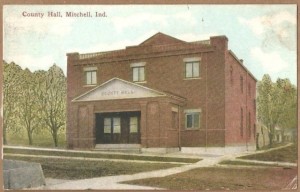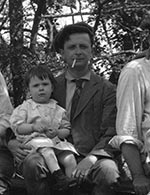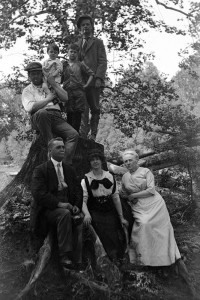History of the Theatre
“Believe you can, and you’re halfway there.”
– Theodore Roosevelt
1906 America. Teddy Roosevelt was President, railroads were king, and the markets for coal, petroleum, limestone and concrete were booming in Indiana.
America’s upper class loved vaudeville, a new art genre called moving pictures had become popular among the masses, and Roosevelt’s Square Deal had energized a host of young entrepreneurs interested in the level playing field brought on by anti-trust legislation.
The Monon and the B&O Railroad lines intersected in southern Indiana in a town named for one of the railroad surveyors: Mitchell. One could hop a train in Chicago or St. Louis and get to New York City via Mitchell, Indiana.
As a result of this new intersection, the town of Mitchell bustled, seeing its share of whistle-stop political speeches, famous vaudeville actors, musicians, and businessmen of all flavors enjoying their new found wealth in the Southern Indiana economy.
In 1901, Lehigh Portland Cement Company moved its headquarters and plant to Mitchell because of the proximity to the railroads. The plant was officially opened in August of 1902. Lehigh Portland recruited and hired over 1,000 men to work in their factory, and the town of Mitchell doubled its size in just three years’ time.
In 1902, the Indiana General Assembly made provisions to assist small communities in developing meeting halls throughout rural Indiana cities. Before the days of television, moving pictures, or even radio, every small city throughout the Midwest had a County Hall. The County Hall was a place for the community to gather for local entertainment as well as political discourse, visiting evangelists, and cultural opportunities of every fashion. The need for a County Hall was exacerbated by the sudden growth of the town, and there was even talk of applying to the state of Indiana to make Mitchell a true city.
 In 1905, bonds were issued by the Bank of Mitchell to build the new County Hall. A plan to rebuild the burned Southern Indiana Normal College was abandoned, and the site and bricks for the project were instead used to build the County Hall.
In 1905, bonds were issued by the Bank of Mitchell to build the new County Hall. A plan to rebuild the burned Southern Indiana Normal College was abandoned, and the site and bricks for the project were instead used to build the County Hall.
The County Hall opened on April 17, 1906. The Mitchell Cadet band provided entertainment, and a host of city and civic leaders spoke. The Mitchell Commercial reported, “It was indeed a treat and we all feel a fitting christening of the County Hall, of which we are justly proud.”
At first, the County Hall was merely a place for local minstrel acts, fundraisers, and political rallies. William Howard Taft gave a stump speech at the County Hall at a political stop on his railroad campaign prior to the 1908 election. Indiana’s fifteen electoral votes went decisively to Taft; stopping in both Mitchell and neighboring Vincennes seemed shrewd political moves for him, considering that his opponent William Jennings Bryan had been doing all he could to court Midwestern business owners and farmers.
While nearly every small Indiana town had a County Hall, Mitchell was unique in the respect that famous vaudeville and musical acts traveling from New York to Los Angeles or Baltimore to Chicago would find their company stopping in Mitchell for respite after a long train excursion. This arrangement was in part due to the foresight and business acumen of a man who became known as one the leading vaudeville, motion picture, and theatrical producers in the United States – Menlo E. Moore.
 Born in Mitchell, Indiana and a grandson of the Bank of Mitchell founder and railroad aficionado Milton Moore, Menlo had studied art at the University of Chicago, was a painter and editorial cartoonist, was involved in the early moving picture industry, and had ties to both George M. Cohan and the Lyric Opera of Chicago.
Born in Mitchell, Indiana and a grandson of the Bank of Mitchell founder and railroad aficionado Milton Moore, Menlo had studied art at the University of Chicago, was a painter and editorial cartoonist, was involved in the early moving picture industry, and had ties to both George M. Cohan and the Lyric Opera of Chicago.
In 1908, Menlo took over the operation of the County Hall and rebranded it as the Opera House. Menlo operated four Opera Houses on a Southern Indiana circuit – Mitchell, Vincennes, his new wife Arna’s home of Washington, and Bedford. It was Menlo’s notion to use his Chicago connections to bring talent from New York to Chicago by way of Southern Indiana.
As a result of Menlo’s tireless work, audiences in rural Indiana were treated to lyric and vaudevillian talent only the most elite families in New York and Chicago might be able afford. These performances were considered by talent to be “barnstorming trips,” rehearsals of sorts where actors and singers could keep their skills sharp while resting from the smoke-filled railroad cars of the era.
However, Menlo had a bit of a marketing problem with Indiana religious and fiscal conservatives who felt that theatre was frivolity at best and unbecoming to moral ladies at worst. His newspaper copy for a show produced in concert with Fred G. Conrad “My Boy, Jack,” a show that was featured at the Mitchell Opera House on September 22, 1909 read enticingly as follows:
The Sort of Play Most People Like to See.
Has a plot, characters, and incidents worthy of admiration.
Is not a bloodthirsty melodrama, but is a delightful comedy drama written by an author who has never had a failure and is said to be the best comedy drama ever written by an American author.
Come in when we get to town and see what we have got.
You won’t be asked to stay if it don’t suit you and we’ll give you your money back to boot.
We want you to have the ‘at home’ feeling when you come to see us, and not the ‘I-wish-I-was-at-home’ feeling.
Don’t imagine you’ll be lonesome. There will be a few others out to see us. We call the theatre filled ‘a few.’
Don’t wait until the last minute to buy your seats and then growl if you don’t get good seats.
We’re expecting you and will give you the greatest value you have ever had for your money.
Menlo’s productions seemed to always have a flair for the dramatic, and the show always went on. During an August 3, 1909 performance of “A Wasted Life,” the leading man from the Shaler-Mack Company actually did have a knife plunged into his back. The supporting actor had inadvertently grabbed a real knife instead of a stage knife, and the actor continued through the evening despite an injury that nearly missed his heart. After the performance, his injuries were treated, and the company went on their way down the line.
While Menlo was out hustling shows for his blossoming Southern Indiana circuit, he had a few bits of vaudevillian-style dramatic intrigue happening in his own family. His wife, the former Washington debutante Arna “Arnie” Padgett was being stalked, compromised, and subsequently blackmailed by one of Indiana’s nouveau-riche oil barons of the day, Charles Edward Gibson.
According to testimony, Gibson had often boasted that he could get any woman he wanted in Vincennes. Gibson made his intentions known to Arnie, and she refused him. Depending upon the source, Gibson either seduced or victimized Arnie at the Grand Hotel in Vincennes while she was staying there during one of Menlo’s performances.
 While Moore was away on travel, Gibson would telegram and visit the Moore’s Mitchell and Vincennes homes, threatening Arnie with exposure should she not continue to agree to his unwelcome advances. Menlo intercepted one of these telegrams, which led a distressed yet relieved Arnie to confess the entire matter to her husband and her father. An enraged Menlo took Arnie and their young son to her parents’ home in Washington, then traveled to Vincennes to confront Gibson.
While Moore was away on travel, Gibson would telegram and visit the Moore’s Mitchell and Vincennes homes, threatening Arnie with exposure should she not continue to agree to his unwelcome advances. Menlo intercepted one of these telegrams, which led a distressed yet relieved Arnie to confess the entire matter to her husband and her father. An enraged Menlo took Arnie and their young son to her parents’ home in Washington, then traveled to Vincennes to confront Gibson.
Gibson was a large, intimidating man of 6’3″ and 300 pounds, while Menlo was 5’6″ and slight. The two met on the train platform early in the morning of October 3, 1910. Gibson was surrounded by bodyguards.
When Gibson saw Menlo, he pushed him aside as he walked past and insulted him. Menlo turned around, pulled out a gun, fired a shot that landed behind Gibson’s left ear, and then stood over his body and emptied the remaining four shots inside the revolver. He then hopped a departing train back to Washington. He was intercepted at the station, allowed to enjoy breakfast with his wife and family, and later was accompanied by his attorney father-in-law, Arnold, to speak with the authorities.
Menlo was charged with first-degree murder but plead guilty by reason of insanity. Since Menlo had offices in Chicago and New York as well as business dealings in theatres around the country, the trial was covered by newspapers throughout the United States. To protect their son and because they owned the Mitchell newspapers, the Moore family managed to keep news of the murder out of Mitchell and neighboring Bedford.
No expense was spared in hiring attorneys and detectives for Moore’s defense. Despite the shame that would be brought to their lives, five women brought forth stories that echoed those of Arnie’s, and the women of Vincennes worked very hard to ensure that none of these provocative testimonies would reach the papers.
On December 9, 1910, Menlo E. Moore was found not guilty of the charge of first-degree murder. His chief counsel, Ephraim Inman, released this dramatic statement:
The human heart is the same the earth around. Law can not rise above its source – the breast of man. This verdict is the crystallization of the purest and best sentiment of the world. It is a declaration that the honor of the wife shall be protected and the purity of the home shall be defended. You may call it the higher law or the lower law, but it is the law that rules the human heart, and as long as this be true, no jury will ever lay its hand upon the man who fights a battle for his home. The blessings that fell from the multitude upon the jury on the announcement of the verdict were but the declaration that this frail young man had struck a blow in the defense of the homes of all. (Indianapolis Star, December 10, 1910).
Menlo was treated as a hero for defending the honor of Arnie and the women of the town of Vincennes. Telegrams from theatrical friends throughout the country arrived in Mitchell, and Menlo and Arnie enjoyed a second honeymoon and train trip to put the incident behind them.
If anything, the results of the trial made Menlo Moore even more desirable as a producer, and his status and influence grew. He opened another office in New York, and he and Arnie moved there to escape their Indiana drama. Menlo was responsible for the distribution of many motion pictures, including D.W. Griffith’s Birth of a Nation in 1915. He continued to funnel Broadway acts and new films through the Opera House and his family’s other Mitchell interest, the Orpheum Theatre.
The Opera House continued to be a place for political discourse. In 1912, Teddy Roosevelt’s Progressive Party sent former Secretary of the Interior and son of former U.S. president James R. Garfield to campaign. On October 21, 1912, Garfield shared the platforms of the new Progressive Party: women’s suffrage, child labor laws, antitrust legislation, and labor’s right to organize.
The message resonated with the local factory and railroad workers and again rallied Indiana to the polls. Another Progressive rally – a “Magnificent Mass Meeting” – was held on November 4 with Indiana Progressive Senator Beveridge, a good friend of Teddy Roosevelt. Despite all of these efforts, old guard Republicans and new, progressive Republicans split their ticket, and Democrat Woodrow Wilson was elected President in November of 1912.
The Mitchell Opera House continued to provide world-class entertainment and escape for local audiences seeking respite from the terrible news of the war front in Europe. The United States entered the war in 1917, and war taxes were added to shows like the popular “Peck’s Bad Boy” to raise money for the boys “over there.”
At the end of the Great War in 1920, the town of Mitchell gathered at the Mitchell Opera House to remember the fallen heroes from Lawrence County and to pray that war would never come again. When some time had passed and the Great War was not quite as fresh, The American Legion sponsored Corporal Bob Ingleston for a three-day event to showcase film shot on the front lines:
Have a father, husband, brother, or sweetheart over there? If so, you may see them in actual battle against the Imperial German army.
6,000 feet of actual battle scenes taken on the Line in France.
Watch the Boys as they go over the top. See them fall dead or wounded as they carry Old “Glory” right into the German lines.
With a humorous lecture in the language of the Doughboy.
The house was packed, and many were reported by the Mitchell Constitution to be turned away from the event.
In October of 1926, Menlo Moore arrived unexpectedly back in Mitchell. He had recently moved his family to Los Angeles in hopes of a better climate for his health. Menlo had been in declining health for a number of months, but no specialist had been able to determine the cause of his infirmities. He believed himself to be dying, and he took one last train trip back to Indiana. He wanted to see his mother and father one last time.
On Monday evening at 6 o’clock on November 22, 1926, Menlo E. Moore passed away of unknown causes at the age of 45. He spent his last days in his parents’ home – the home in which he had grown up. The theatrical giant had created a show business empire of stage and screen, trying out many of his acts with audiences at the Mitchell Opera House. He was survived by Arnie and their son and two daughters.
His funeral services were held in his parents’ home – a still-standing house on the northwest corner of Eighth and Brook streets in Mitchell and within direct sight of the Opera House. With the loss of Menlo, the heart of the Opera House was gone. A few remaining theatrical contracts were honored in 1927, but for the most part, the heyday of the Mitchell Opera House died with Menlo.
In 1928, the Orpheum Theatre in Mitchell put in a new sound system to accommodate the new “Talking Pictures,” and Lawrence County audiences flocked to see these new marvels of entertainment. The Mitchell Opera House had no sound system nor indoor plumbing. Plans to upgrade the Opera House were abandoned after the Wall Street Crash of 1929 and the beginning of the Great Depression.
Lawrence County fared the Depression better than most areas as FDR’s New Deal WPA projects required building materials like limestone and concrete. However, save a few Mitchell High School performances and stray political rallies, the Opera House sat mostly empty as a monument to a bygone era of Progressive, turn-of-the-century culture and the Roaring Twenties.
At the end of World War II, the Mitchell Rotary Club decided to organize and turn the Opera House into a Teen Canteen. The chairs were removed, booths were installed, and volunteers created a space to keep teenagers out of mischief. From 1946 to 1958, a jukebox spun top-40 records, popcorn and Cokes were sold as concessions, and volunteer chaperones monitored junior high kids on Friday nights and high school students on Saturdays.
Special Sweetheart events on Valentine’s Day, Christmas dances, and pep rallies for basketball games raised money to keep the Teen Canteen operational. Many young romances were fostered on the dance floor under the sharp eye of Rotary chaperones, and it was imperative that young ladies not leave the facility “without a proper escort.”
When the Teen Canteen fell out of fashion in 1958, the City of Mitchell turned the Opera House building into the Mitchell City Hall. The stage was raised and the back wall opened to accommodate fire trucks, the police department was housed stage right, and Mitchell citizens filed in to apply for marriage licenses and pay their water bills. In the 1970s, Mitchell built a new City Hall, and the Opera House building stood empty once again.
While a student at the Theatre Department of Indiana University at Bloomington, Mitchell native Doug Hartzell wrote a paper about the Mitchell Opera House for one of his classes in the early 1980s. University professors urged Doug to do something to preserve this historic structure, and he took that admonition as a call to action. Doug formed a new non-profit, Opera House Inc., for the purposes of restoring and reclaiming this space.
The Hartzell family, together with members of the Mitchell-Grissom Kiwanis Club and various Mitchell citizens, embarked on a valiant restorative effort. The building was gutted and cleaned, the stage was lowered, a new balcony was added, and seating salvaged from a period Louisville theatre slated to be raised was installed.
Much like Menlo Moore before him, Doug Hartzell used his new theatre and Chicago connections to book acts and talent at the Mitchell Opera House. After overseeing the Mitchell Opera House renovations and bringing biweekly variety, musical, and theatrical acts back to Bedford, Doug relocated to Chicago, served as General Manager of the Halsted Theatre from 1991 to 1993, and funneled world-class talent back to his beloved theatre in his hometown of Mitchell.
In 1997, Doug came back to his home of Mitchell, Indiana, to be with his parents to convalesce after an illness. Douglas L. Hartzell passed away on July 19, 1997 in the home of his parents, Peggy and Buford “Bud” Hartzell, and he is buried in Mitchell.
Peggy and Bud continued to run the theatre until their health declined, and Peggy was known to book acts for the Mitchell Opera House from her hospital bed until her death in 2012. Married for nearly sixty years, the couple never faltered in keeping Doug’s dream alive for the benefit of audiences in the region.
In 2014, at the urging of the citizens of Mitchell, the City of Mitchell tasked community organization Hoosier Uplands with the historical renovation and preservation of the Mitchell Opera House. A grand opening occurred on July 4, 2015 to showcase the new state of the art sound and video projection system. Hoosier Uplands has returned the Mitchell Opera House to its former glory as the crown jewel of entertainment in Southern Indiana.

 © 2015
© 2015